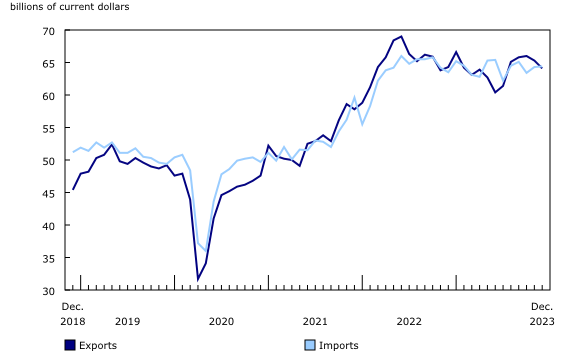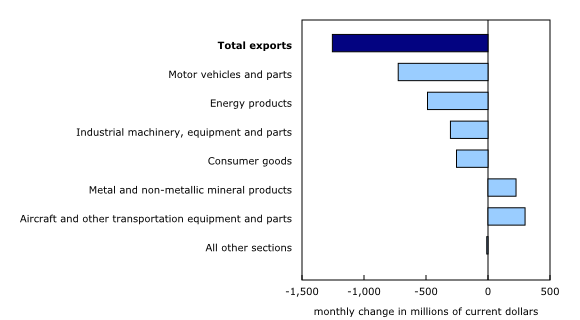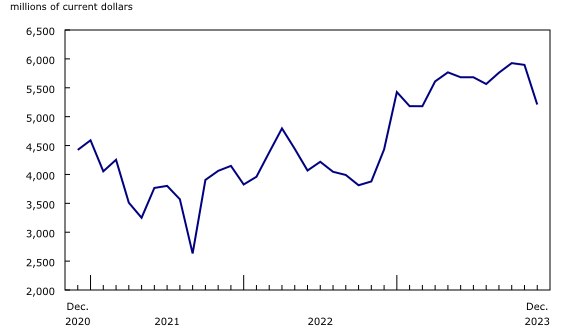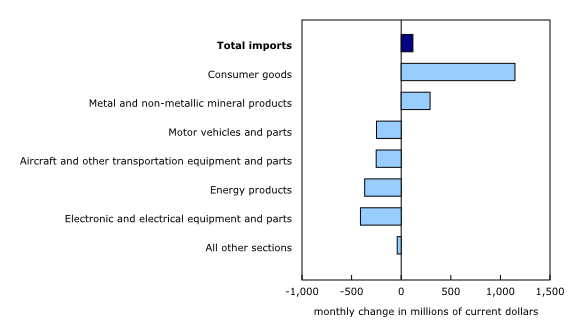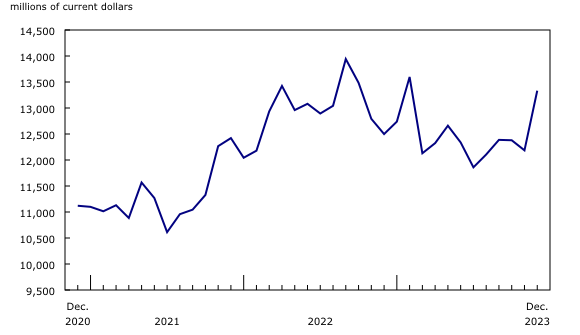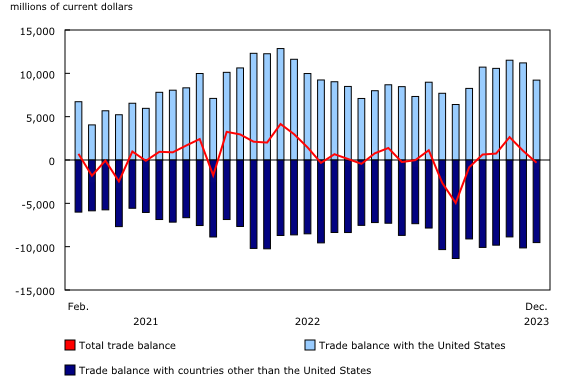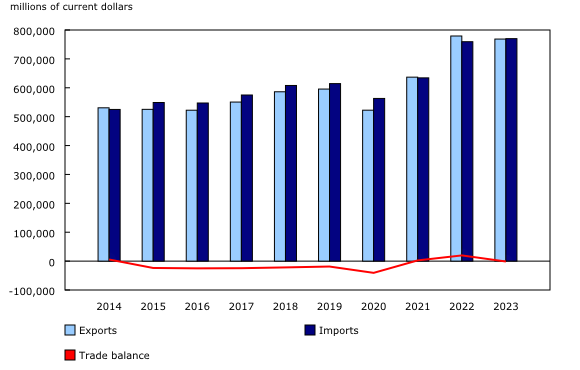Canadian international merchandise trade, December 2023
Released: 2024-02-07
In December, Canada's merchandise exports decreased 1.9%, while imports edged up 0.2%. As a result, Canada's merchandise trade balance with the world went from a surplus of $1.1 billion in November to a deficit of $312 million in December, the first monthly trade deficit since July. The December deficit is close to the typical bounds for monthly revisions to imports and exports.
Consult the "International trade monthly interactive dashboard" to explore the most recent results of Canada's international trade in an interactive format.
The appreciation of the Canadian dollar impacts import and export values
A large proportion of import and export transactions are completed in US dollars and must be converted to Canadian dollars to compile monthly trade statistics. When the Canadian dollar appreciates against the US dollar, monthly trade values expressed in Canadian dollars are lower.
In December, the average value of the Canadian dollar increased 1.5 cents US compared with the average value in November. This represents the largest monthly gain since May 2021. When expressed in US dollars, Canadian exports edged up 0.1% in December 2023, and imports rose 2.3%.
Decrease in exports of passenger cars and light trucks as well as crude oil
Total exports fell 1.9% in December, a second consecutive monthly decline. Decreases were observed in 7 of the 11 product sections. In real (or volume) terms, total exports fell 0.4% in December.
Exports of motor vehicles and parts were down 8.2% in December. Exports of passenger cars and light trucks (-11.6%) contributed the most to the decline. This decrease was due in part to a gradual slowdown in the production of certain models that will soon no longer be manufactured in Canada or that will be manufactured at other Canadian plants. In the future, new models, including electric vehicles, are expected to be introduced to Canadian manufacturing plants. Despite the decrease in December, exports of motor vehicles and parts finished 2023 up 26.2% from 2022, reaching unparalleled annual levels.
Exports of energy products fell 3.1% in December. The largest contributor to this decline was crude oil exports (-4.9%), which were also down in November. Both the November and December decreases were the result of lower crude oil prices, which were pushed downward in the last few months in part because of oversupply and concerns over demand. Meanwhile, in volume terms, crude oil exports posted a fifth consecutive monthly increase. This occurred as crude oil production increased in Alberta in the fall of 2023 with the completion of maintenance work at upgrading facilities.
Offsetting movements in imports
Total imports edged up 0.2% in December, despite declines in 8 of the 11 product sections. Imports of consumer goods posted the largest gain. Excluding this product section, imports were down 2.0% in December. In real (or volume) terms, total imports rose 1.3%.
Imports of consumer goods were up 9.4% in December. This was the strongest monthly increase on record for this product section. Imports of pharmaceutical products rose 28.1%, contributing the most to the December increase. While imports of pharmaceutical products have posted declines in the month of December in previous years, they rose in December 2023 because of atypical high-value imports from the United States. Other product groups, such as clothing, footwear and accessories (+11.4%), miscellaneous goods and supplies (+6.5%) and alcoholic beverages (+18.9%), also posted notable increases.
Imports of metal and non-metallic mineral products (+5.8%) also contributed to the overall increase in December. Imports of unwrought gold, silver, and platinum group metals (+15.8%) posted a second consecutive monthly gain, mainly on higher purchases of unwrought gold in the United States. Imports of basic and semi-finished products of non-ferrous metals (+27.7%) were also up in December.
The increases in the above product sections were almost entirely offset by lower imports in several other product sections, including electronic and electrical equipment and parts (-5.7%); energy products (-9.9%); aircraft and other transportation equipment and parts (-11.7%); and motor vehicles and parts (-2.1%).
Lower exports to the United States, higher exports to other countries
Exports to the United States were down 3.4% in December, falling for a third consecutive month. Meanwhile, imports from the United States increased 0.7%. As a result, Canada's merchandise trade surplus with the United States narrowed from $11.2 billion in November to $9.2 billion in December.
Exports to countries other than the United States were up 3.3% in December. Gains were observed in exports to Italy (aircraft and pharmaceutical products), Hong Kong (unwrought gold), Norway (nickel) and Australia (aircraft). Imports from countries other than the United States were down 0.6%, due in part to lower imports from the United Kingdom (unwrought gold).
Canada's trade deficit with countries other than the United States narrowed from $10.1 billion in November to $9.5 billion in December.
Energy products drive the quarterly increase in exports for a second consecutive quarter
After increasing 2.8% in the third quarter, exports rose 1.6% in the fourth quarter. Exports of energy products (+6.2%) contributed the most to the quarterly increase. Excluding this product section, exports edged up 0.3% in the fourth quarter.
Imports were up 0.2% in the fourth quarter. Offsetting movements in imports of consumer goods (+4.3%) and imports of motor vehicles and parts (-4.3%) were observed in the fourth quarter.
In real terms, quarterly exports increase, while imports decline
In real terms (calculated using 2017 chained dollars), exports were up 1.0% in the fourth quarter of 2023. This followed a decline of 0.4% in the third quarter. Real exports of energy products (+4.9%) contributed the most to the increase in the fourth quarter, which coincided with higher crude oil production in Alberta.
Real imports were down 0.5% for a second consecutive quarter. After a record third quarter, imports of motor vehicles and parts (-5.0%) decreased the most in the fourth quarter.
Canada's merchandise trade balance for the year 2023 was essentially balanced
Canada's annual merchandise trade balance with the world moved from a surplus of $19.7 billion in 2022 to a slight deficit of $1.4 billion in 2023. The change in the annual merchandise trade balance was attributable to higher imports (+1.4%) combined with a virtually equivalent decrease in exports (-1.4%).
The gain in imports in 2023 was largely attributable to a sharp increase in imports of motor vehicles and parts (+19.5%), while the drop in exports was driven by a large decline in exports of energy products (-18.9%).
In terms of trade activity, Canada's total merchandise trade (imports plus exports) remained essentially unchanged in 2023, standing at $1.5 trillion for a second consecutive year.
Consult "The International Trade Explorer" to explore the annual results of Canada's international trade (on a customs basis) in an interactive format.
Revisions to November merchandise export and import data
Imports in November, originally reported at $64.2 billion in the previous release, were revised to $64.3 billion in the current reference month's release. Exports in November, originally reported at $65.7 billion in the previous release, were revised to $65.3 billion in the current reference month's release.
Monthly trade in services
In December, monthly service exports were up 1.3% to $16.9 billion. Meanwhile, imports edged up 0.3% to $17.6 billion.
When international trade in goods and services are combined, exports decreased 1.3% to $80.9 billion in December, while imports increased 0.2% to $82.0 billion. As a result, Canada's total trade balance with the world went from a slight surplus of $173 million in November to a deficit of $1.0 billion in December.
Did you know we have a mobile app?
Get timely access to data right at your fingertips by downloading the StatsCAN app, available for free on the App Store and on Google Play.
Note to readers
Information on concepts and methods used for the monthly release of Canada's international merchandise trade is now available online. Please see Notes on the monthly release of Canadian international merchandise trade for more details.
Guide to Canadian International Merchandise Trade Statistics
The "Guide to Canadian International Merchandise Trade Statistics" (13-605-X) is now available. This guide provides essential definitions, describes key concepts and methodology, and outlines data processes for Canadian International Merchandise Trade statistics. An overview of the published data, including descriptions of product, industry, and geographical classifications, is provided along with links to the products where these data are available.
Recent changes within the Canadian International Merchandise Trade program
On December 6, 2023, Statistics Canada updated the North American Product Classification System (NAPCS) used for merchandise import and export statistics from NAPCS 2017 to NAPCS 2022. Additionally, the reference year applicable to merchandise trade price and volume indexes has been updated from 2012 to 2017 (2017=100). For more information, please see Variant of NAPCS Canada 2022 Version 1.0 – Merchandise import and export accounts, or contact International Accounts and Trade Division Client Services at (itdtrade@statcan.gc.ca).
Note on the potential US government shutdown
Under a 1990 agreement between Canada and the United States, each country uses the other's import data to produce statistics on its exports. If a US government shutdown were to occur and affect the Department of Commerce, the United States Census Bureau would close, and Statistics Canada would not receive data on Canada's exports to the United States for the duration of the shutdown. As in the past, a prolonged shutdown could lead to a postponement of the publication of Canadian International Merchandise Trade statistics. Statistics Canada is closely monitoring this situation and will provide further information on potential impacts to its statistical programs as needed.
Real-time data table
The real-time data table 12-10-0165-01 will be updated on February 19.
Next release
Data on Canadian international merchandise trade for January will be released on March 7.
Products
The product "International trade monthly interactive dashboard" (71-607-X) is now available. This new interactive dashboard is a comprehensive analytical tool that presents monthly changes in Canada's international merchandise trade data on a balance-of-payments basis, fully supporting the information presented every month in the Daily release.
The product "The International Trade Explorer" (71-607-X) is now available online.
The online Canadian International Merchandise Trade Database is no longer available. It has been replaced by the Canadian International Merchandise Trade Web Application (71-607-X), a modern tool that provides trade data users with a number of enhancements.
The updated "Canada and the World Statistics Hub" (13-609-X) is now available online. This product illustrates the nature and extent of Canada's economic and financial relationship with the world using interactive charts and tables. It provides easy access to information on trade, investment, employment and travel between Canada and a number of countries, including the United States, the United Kingdom, Mexico, China, Japan, Belgium, Italy, the Netherlands and Spain.
Contact information
For more information, or to enquire about the concepts, methods or data quality of this release, contact us (toll-free 1-800-263-1136; 514-283-8300; infostats@statcan.gc.ca) or Media Relations (statcan.mediahotline-ligneinfomedias.statcan@statcan.gc.ca).
- Date modified:



